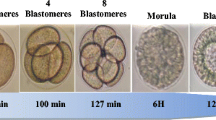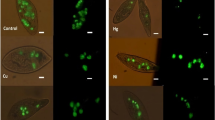Abstract
The toxicity of cadmium and zinc mixtures at concentrations ranging from 0.1 to 10,000 μg/L was investigated against the survival of the free-living cercarial stage of the parasitic fluke Diplostomum spathaceum. Cercariae were exposed to metal mixtures of equal concentration, metal mixtures of unequal concentration, and low-dose pretreatment followed by high-dose exposure mixtures. Under all exposures cercarial survival was increased compared to that achieved with single metals. At exposures with metal mixture of equal concentration in the range 0.1–100 μg/L survival was increased compared to that achieved by controls. The mechanism of metal toxicity and their effects on cercarial survival are discussed.
Similar content being viewed by others
Author information
Authors and Affiliations
Additional information
Received: 17 November 2001/Accepted: 4 February 2002
Rights and permissions
About this article
Cite this article
Morley, N., Crane, M. & Lewis, J. Toxicity of Cadmium and Zinc Mixtures to Diplostomum spathaceum (Trematoda: Diplostomidae) Cercarial Survival. Arch. Environ. Contam. Toxicol. 43, 28–33 (2002). https://doi.org/10.1007/s00244-002-1244-x
Issue Date:
DOI: https://doi.org/10.1007/s00244-002-1244-x




